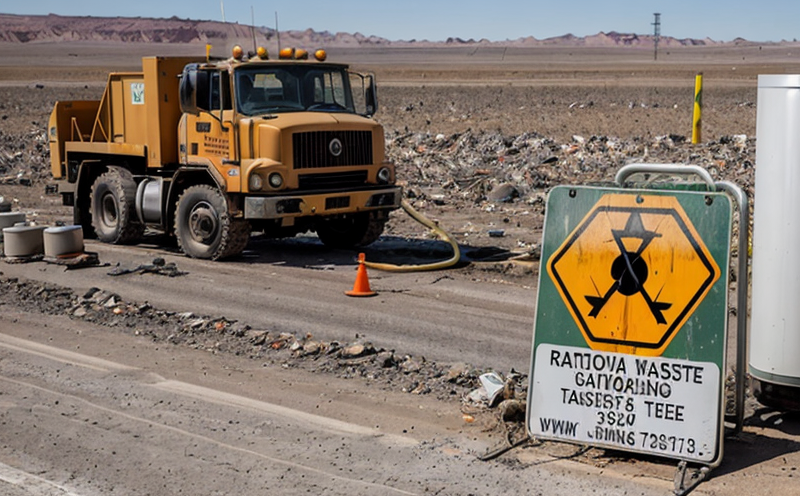ASTM C1129 Alpha Spectrometry of Radioactive Waste Samples
The ASTM C1129 method for alpha spectrometry is a critical analytical technique used to characterize the presence and concentration of alpha-emitting radionuclides in radioactive waste samples. This service is essential for ensuring regulatory compliance, environmental protection, and worker safety in sectors dealing with hazardous waste.
Alpha radiation is highly energetic but has limited penetration depth due to its strong interaction with matter. Consequently, it poses a significant risk only when inhaled or ingested. The ASTM C1129 method allows for the accurate quantification of alpha-emitting radionuclides like polonium-210 (Po-210) and plutonium isotopes, which are key components in many radioactive waste streams.
The process begins with the preparation of a homogeneous sample using appropriate methods such as dissolution or filtration. Once prepared, the sample is loaded onto an alpha-emitting source holder that ensures stable emission during measurement. The instrument used for this analysis typically consists of a high-purity germanium (HPGe) detector coupled with a low-background gamma-ray shield and a multi-channel analyzer.
The detection efficiency of HPGe detectors makes them ideal for quantifying alpha emitters, providing precise results even at low activity levels. After acquisition, the data are analyzed using specialized software to determine the specific activities of each detected radionuclide. This information is then reported in units consistent with international standards such as Bq/kg or Ci/g.
The ASTM C1129 method ensures accuracy and precision by adhering strictly to predefined criteria outlined in the standard itself. These include stringent quality control measures, calibration protocols, and validation procedures. Regular inter-laboratory comparisons further reinforce confidence in the results produced through this service.
Understanding the alpha activity content of radioactive waste is crucial for several reasons. It helps determine whether a material can be classified as low-activity or high-level waste under regulatory frameworks like those established by international organizations such as the International Atomic Energy Agency (IAEA). Accurate characterization also enables informed decisions regarding disposal methods, treatment processes, and ultimately, proper management strategies.
Compliance with relevant regulations is paramount in handling radioactive materials. By employing ASTM C1129 alpha spectrometry, laboratories ensure they meet stringent requirements set forth by national and international bodies responsible for radiation safety. This not only protects public health but also fosters trust among stakeholders involved in nuclear waste management.
To summarize, ASTM C1129 alpha spectrometry is a robust analytical technique providing precise quantification of alpha-emitting radionuclides within radioactive waste samples. Its application ensures accurate classification and safe handling practices, thereby contributing significantly to environmental protection and occupational safety.
Benefits
- Precise quantification of alpha-emitting radionuclides in waste samples.
- Compliance with national and international regulatory requirements.
- Informed decision-making for disposal methods and treatment processes.
- Enhanced worker safety through accurate characterization.
- Environmental protection by ensuring proper management practices.
Quality and Reliability Assurance
To maintain the highest standards of quality and reliability, our laboratory adheres strictly to ASTM C1129 guidelines throughout every step of the process. From sample preparation to data analysis, each procedure is meticulously documented and reviewed by qualified personnel.
We employ robust calibration protocols using certified reference materials (CRMs) to ensure consistent performance across all measurements. Regular inter-laboratory comparisons further validate our results against those obtained by other reputable institutions worldwide. Additionally, we maintain strict quality control measures including internal audits and proficiency testing programs recognized by authoritative bodies such as the National Institute of Standards and Technology (NIST).
Our commitment to excellence extends beyond mere adherence to standards; it encompasses continuous improvement efforts aimed at enhancing both technical capabilities and service delivery. By doing so, we guarantee that clients receive reliable, accurate results they can trust.
Use Cases and Application Examples
| Scenario | Description |
|---|---|
| Determination of Plutonium Content in Spent Fuel Rods | This example demonstrates how ASTM C1129 can be utilized to measure the alpha activity associated with plutonium isotopes found within spent nuclear fuel rods. Such information is vital for assessing radiation risks and planning appropriate decommissioning strategies. |
| Classification of Radioactive Waste Streams | In this scenario, ASTM C1129 helps differentiate between low-activity waste and high-level radioactive material based on detected alpha activity levels. Accurate classification is essential for determining the most suitable disposal facilities and treatment methods. |
| Scenario | Description |
|---|---|
| Assessment of Decontamination Efficiencies | This application involves monitoring the reduction in alpha activity over time following decontamination efforts. By quantifying decreases in detected activities, stakeholders can evaluate the effectiveness of their cleaning protocols. |
| Support for Regulatory Compliance Audits | ASTM C1129 results serve as crucial evidence during regulatory inspections. They provide verifiable data supporting compliance with national and international standards governing radioactive waste management practices. |





